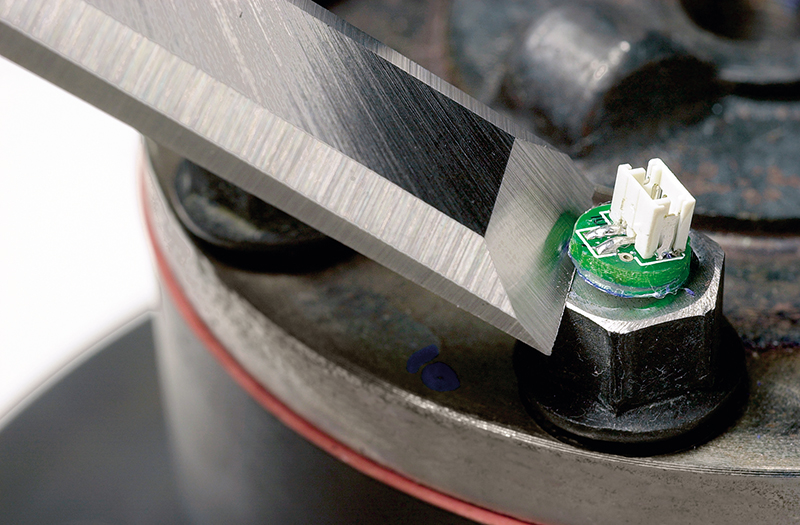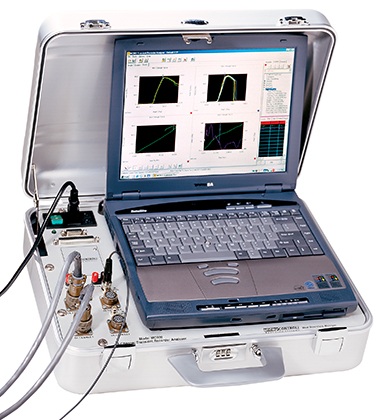
Sensing the Tension
Spanning over 4 decades, NASA's bolt tension monitoring technology has benefited automakers, airplane builders, and other major manufacturers that rely on the devices to evaluate the performance of computerized torque wrenches and other assembly line mechanisms. In recent years, the advancement of ultrasonic sensors has drastically eased this process for users, ensuring that proper tension and torque are being applied to bolts and fasteners, with less time needed for data analysis.
Langley Research Center's Nondestructive Evaluation Branch is one of the latest NASA programs to incorporate ultrasonic sensors within a bolt tension measurement instrument. As a multi-disciplined research group focused on spacecraft and aerospace transportation safety, one of the branch's many commitments includes transferring problem solutions to industry. In 1998, the branch carried out this obligation in a licensing agreement with Micro Control, Inc., of West Bloomfield, Michigan. Micro Control, an automotive inspection company, obtained the licenses to two Langley patents to provide an improved-but-inexpensive means of ultrasonic tension measurement.
Prior to the agreement, the company's existing standard product could measure up to four channels of torque/tension (strain gauge-based), the angle of bolt/fastener rotation, and other analog input channels, but lacked the ultrasonic element and the ability to perform all of these functions at the same time. By licensing NASA technology, Micro Control integrated the ultrasonic measurement aspect into its standard product, which enabled it to measure bolt tension directly using standard fasteners, and acquired the knowledge to measure torque/tension and angle rotation simultaneously.
The new MC900 Transient Recorder Analyzer provides fastener engineers with a powerful tool for studying threaded fastener joint designs or dynamic analysis of nut-runner operations on the plant floor or in a laboratory environment. The biggest challenge for a fastener engineer working in these areas is determining the clamp force between the two parts that are intended to be fastened together. In the past, the only information available to the engineer was the bolt's torque and angle of rotation. This required the engineer to establish a relationship between torque and tension. Based on this relationship, a determination could be made on the torque strategy that would be used in production.
The problem with this method, however, is that slight changes in thread friction or bolt geometry from one bolt to another can cause substantial errors between applied torque or rotation and the actual clamping force of the fastener. With the MC900 analyzer, data analysis and collection becomes simplified for the engineer, thereby diminishing the challenge of the clamp force process. Engineers can use the tool to ultrasonically measure the clamping force of the bolted joint during production without the need for specially fabricated bolts instrumented with strain gauges.
According to Micro Control, conventional ultrasonic testing methods can only measure elongation/load, based on the theoretical values and geometry of a bolt. Though in reality, the materials in the bolt rarely match exactly to the published standard materials, and the geometrical complexities of the bolt make it difficult to decipher accurate elongation. Additionally, the theoretical method only works in the elastic region of the bolt.
In contrast, MC900 allows for analyzation of the theoretical values and geometry of the bolt; calibration of a sample of bolts with a known load, using a load cell or tensile machine and then using the averaged results; or calibration of each bolt individually by pulling the bolts with the tensile machine. An accurate relationship between elongation and load is established, and the user can witness the performance of the bolt beyond the elastic region, and into the plastic region.
For determining ultrasonic delays and strain in a bolt, MC900 employs Langley's "pulsed phase-lock loop" technology. This system sends a toneburst through an ultrasonic transducer, which transmits a series of high-frequency sound waves into a specimen (the NASA technology utilizes just one frequency of sound waves, as opposed to the broad frequency spectrum occupied by traditional ultrasonic tension measurements). The sound waves' echo is then received from the far end of the bolt, and the phase shift is computed by comparing the phase of the returned signal with that of the original toneburst as the bolt is tightened. To identify the specific cycle in the return echo for elongation measurement, MC900 applies pattern matching, keeping the reference echo in memory for subjective comparison with the final echo. Each of the device's four channels can be programmed as "pitch catch"—with transducers on both ends of the bolt, "pulse echo"—with a single transducer on one end of the bolt, or "multiple echo," depending on the physical properties of the bolts to be measured.
MC900's powerful hardware/Microsoft® Windows®-based software combination comes fully loaded with user options, including additional tuning filters to accommodate different ultrasonic transducers, ID recognition for smart sensors, statistical and graphical analysis in real time, cross-plotting, automatic or manual calibration, and unlimited recording time of data.
Micro Control also developed and patented a low-cost, reusable "glue on" ultrasonic tension sensor called a UTensor™ that can be used in conjunction with the MC900 device to produce the accuracy and repeatability heavily needed in the automotive industry. By gluing the UTensor onto a fastener, the user can measure the preload, or relaxation point, after tightening a bolt.
Currently, "big three" automakers General Motors Corporation, Ford Motor Company, and DaimlerChrysler, along with their suppliers and bolt manufacturers, are incorporating the MC900 and UTensor technology.
Microsoft® and Windows® are registered trademarks of Microsoft Corporation.
UTensor™ is a trademark of Micro Control, Inc.

The MC900 Transient Recorder Analyzer is available in a portable laptop model (shown here encased in aluminum), or a desktop model made from high-impact plastic. Standard specifications include four strain gauge input channels, four high-level analog input channels, and four digital input and output channels, among other features.

Micro Control, Inc.'s UTensor, a low-cost, reusable glue on ultrasonic tension sensor, provides dynamic reading of tension while a bolt is being tightened.













